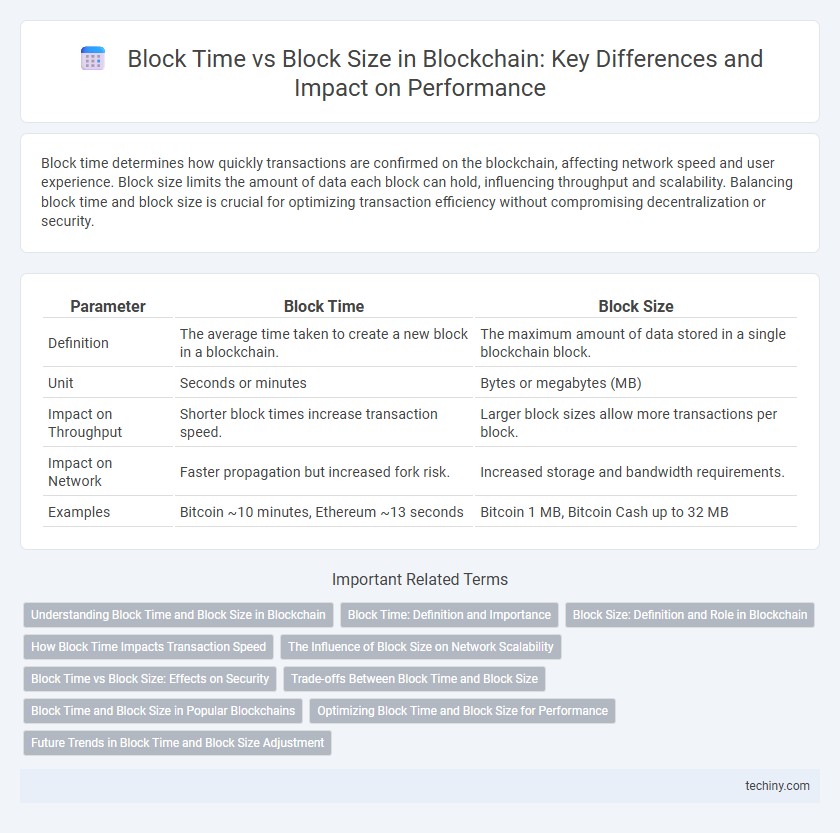Block time determines how quickly transactions are confirmed on the blockchain, affecting network speed and user experience. Block size limits the amount of data each block can hold, influencing throughput and scalability. Balancing block time and block size is crucial for optimizing transaction efficiency without compromising decentralization or security.
Table of Comparison
| Parameter | Block Time | Block Size |
|---|---|---|
| Definition | The average time taken to create a new block in a blockchain. | The maximum amount of data stored in a single blockchain block. |
| Unit | Seconds or minutes | Bytes or megabytes (MB) |
| Impact on Throughput | Shorter block times increase transaction speed. | Larger block sizes allow more transactions per block. |
| Impact on Network | Faster propagation but increased fork risk. | Increased storage and bandwidth requirements. |
| Examples | Bitcoin ~10 minutes, Ethereum ~13 seconds | Bitcoin 1 MB, Bitcoin Cash up to 32 MB |
Understanding Block Time and Block Size in Blockchain
Block time in blockchain refers to the average time it takes to create a new block, directly impacting transaction confirmation speed and network throughput. Block size determines the maximum amount of data included in each block, influencing the number of transactions processed per block and overall scalability. Optimizing both block time and block size is crucial for balancing efficiency, decentralization, and security in blockchain networks.
Block Time: Definition and Importance
Block time refers to the average duration it takes for a new block to be added to a blockchain, typically measured in seconds or minutes depending on the network protocol. This metric is crucial for determining transaction confirmation speed and network efficiency, influencing user experience and security through block propagation and consensus mechanisms. Optimizing block time balances throughput and decentralization, ensuring timely updates while maintaining the integrity of the distributed ledger.
Block Size: Definition and Role in Blockchain
Block size in blockchain refers to the maximum amount of data or transactions that can be included in a single block, directly impacting network throughput and scalability. Larger block sizes enable more transactions per block, reducing congestion and transaction fees, but may increase propagation time and hardware requirements for nodes. Optimizing block size balances transaction capacity with decentralization, ensuring efficient network performance and security.
How Block Time Impacts Transaction Speed
Block time directly affects transaction speed by determining how quickly new blocks are added to the blockchain, with shorter block times resulting in faster confirmation of transactions. However, reducing block time too much can increase the risk of orphaned blocks and network instability. Balancing block time with block size is essential to optimize throughput and maintain a secure, efficient blockchain network.
The Influence of Block Size on Network Scalability
Block size directly impacts network scalability by determining the volume of transactions processed per block, with larger blocks enabling higher throughput but potentially increasing propagation delay and centralization risks. Optimal block size balances transaction capacity and network efficiency, as excessively large blocks can slow down consensus and increase orphan rates. Network performance depends on carefully tuning block size to maintain decentralization while scaling transaction throughput.
Block Time vs Block Size: Effects on Security
Block time refers to the interval required to generate a new block in a blockchain, while block size dictates the amount of transaction data each block can hold. Shorter block times can lead to faster transaction confirmations but may increase the risk of orphaned blocks and reduce overall network security due to propagation delays. Conversely, larger block sizes allow more transactions per block but can cause slower propagation and greater centralization risks, impacting the blockchain's security robustness.
Trade-offs Between Block Time and Block Size
Trade-offs between block time and block size critically impact blockchain scalability and security. Shorter block times improve transaction throughput but increase the risk of forks and reduce network security due to propagation delays. Larger block sizes enhance transaction capacity per block but lead to longer propagation times, higher bandwidth requirements, and potential centralization risks as fewer nodes can process massive blocks efficiently.
Block Time and Block Size in Popular Blockchains
Bitcoin's average block time is approximately 10 minutes with a block size limit of 1 MB, balancing security and decentralization. Ethereum processes blocks roughly every 12-14 seconds, with variable block sizes determined by gas limits rather than a fixed size. Litecoin offers faster block times around 2.5 minutes with a 1 MB block size, enabling quicker transaction confirmations but requiring efficient space management.
Optimizing Block Time and Block Size for Performance
Optimizing block time and block size is crucial for blockchain performance, as shorter block times improve transaction speed while larger block sizes increase throughput. Balancing these parameters reduces network congestion and enhances scalability without compromising security or decentralization. Fine-tuning block time to around 10 minutes, as seen in Bitcoin, and adjusting block size based on network demand ensures efficient transaction processing and maintains blockchain integrity.
Future Trends in Block Time and Block Size Adjustment
Future trends in blockchain emphasize dynamic block time reduction to enhance transaction throughput and network scalability, leveraging advancements like layer-2 solutions and sharding. Adaptive block size algorithms are increasingly implemented, enabling real-time adjustment based on network congestion and demand, which optimizes storage efficiency and minimizes latency. Emerging consensus mechanisms, including Proof of Stake (PoS) upgrades, support flexible block parameters, driving more efficient and sustainable blockchain ecosystems.
Block time vs Block size Infographic

 techiny.com
techiny.com